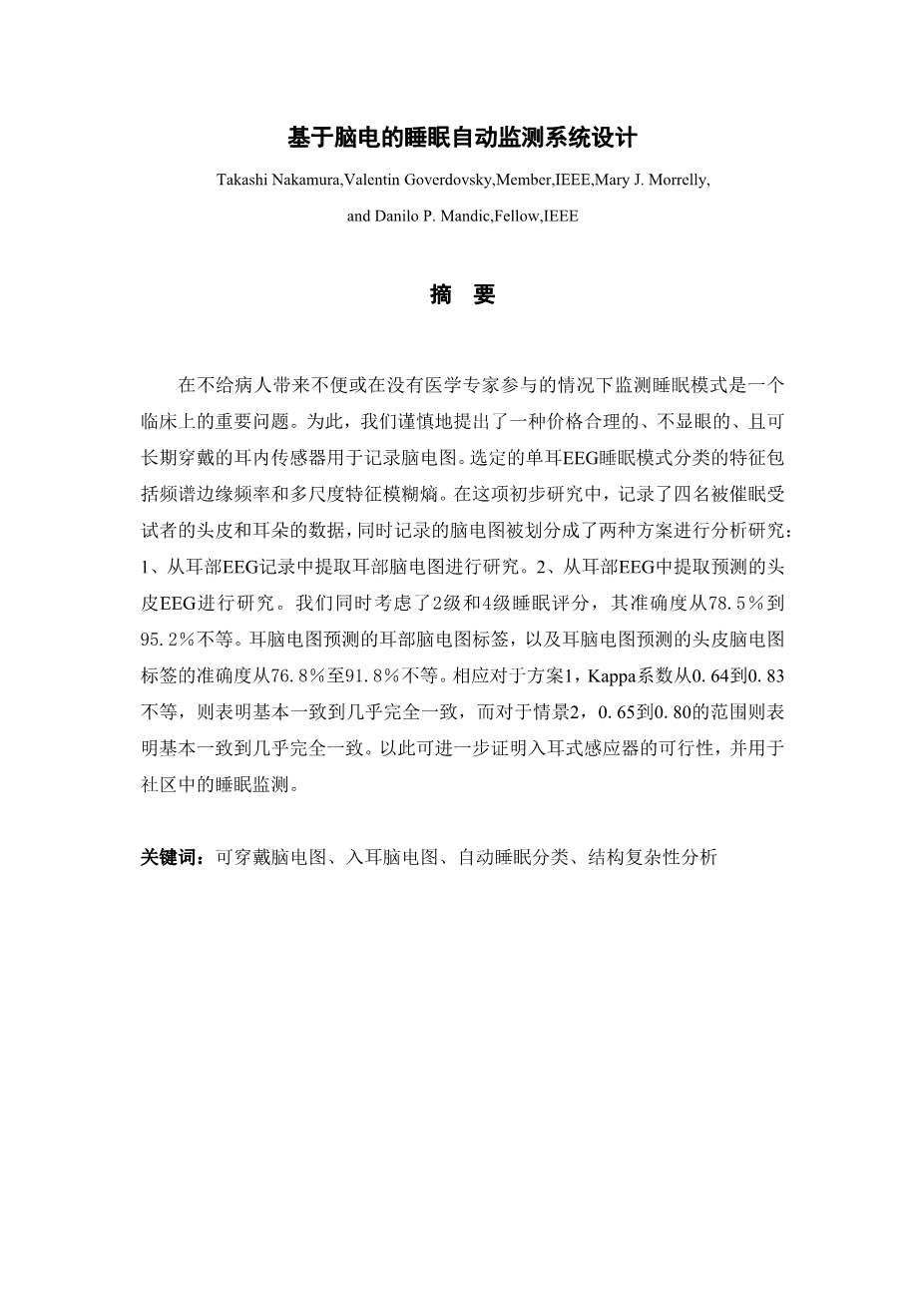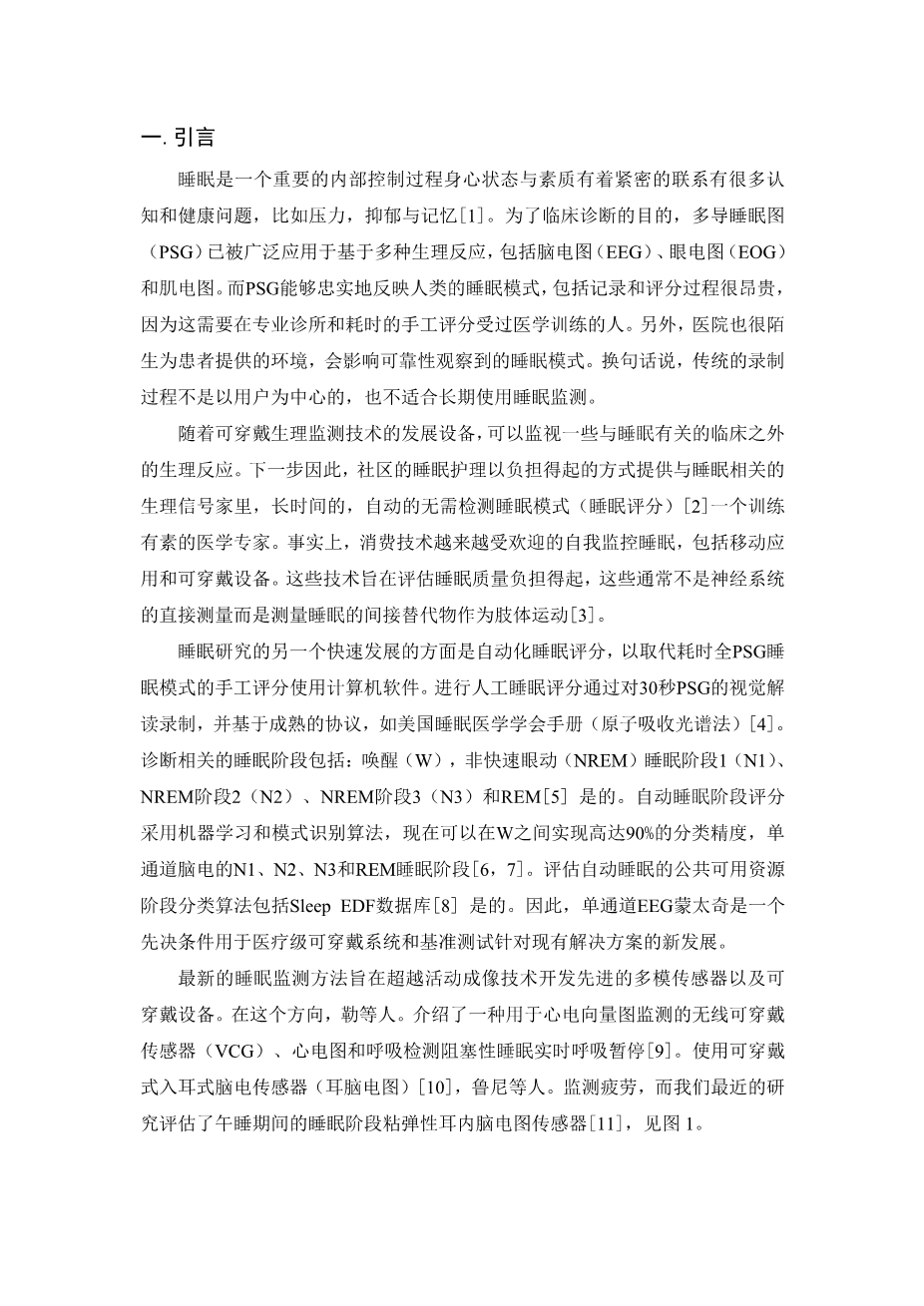Automatic sleep monitoring using ear-EEG
Takashi Nakamura_, Valentin Goverdovsky_, Member, IEEE, Mary J. Morrelly,
and Danilo P. Mandic_, Fellow, IEEE
Abstract
The monitoring of sleep patterns without patient’s inconvenience or involvement of a medical specialist is a clinical
question of significant importance. To this end, we propose an automatic sleep stage monitoring system based on an affordable,
unobtrusive, discreet, and long-term wearable in-ear sensor for recording the Electroencephalogram (ear-EEG). The selected
features for sleep pattern classification from a single ear-EEG channel include the spectral edge frequency (SEF) and multiscale
fuzzy entropy (MSFE), a structural complexity feature. In this preliminary study, the manually scored hypnograms from
simultaneous scalp-EEG and ear-EEG recordings of four subjects are used as labels for two analysis scenarios: 1) classification
of ear-EEG hypnogram labels from ear-EEG recordings and 2) prediction of scalp-EEG hypnogram labels from ear-EEG
recordings. We consider both 2-class and 4-class sleep scoring, with the achieved accuracies ranging from 78.5% to 95.2% for
ear-EEG labels predicted from ear-EEG, and 76.8% to 91.8% for scalp-EEG labels predicted from ear-EEG. The corresponding
Kappa coefficients range from 0.64 to 0.83 for Scenario 1, and indicate Substantial to Almost Perfect Agreement, while for
Scenario 2 the range of 0.65 to 0.80 indicates Substantial Agreement, thus further supporting the feasibility of in-ear sensing
for sleep monitoring in the community.
Index Terms – Wearable EEG, in-ear sensing, ear-EEG, automatic sleep classification, structural complexity analysis
I. INTRODUCTION
Sleep is an essential process in the internal control of the
state of body and mind and its quality is strongly linked
with a number of cognitive and health issues, such as stress,
depression and memory [1]. For clinical diagnostic purposes,
polysomnography (PSG) has been extensively utilised which is
based on a multitude of physiological responses, including the
electroencephalogram (EEG), electrooculogram (EOG), and
electromyogram (EMG). While the PSG is able to faithfully
reflect human sleep patterns, both the recording and scoring
process are expensive as this involves an overnight stay in a
specialised clinic and time-consuming manual scoring by a
medically trained person. In addition, hospitals are unfamiliar
environments for patients, which compromises the reliability
of the observed sleep patterns. In other words, the conventional
recording process is not user-centred and not ideal for longterm
sleep monitoring.
With the advance in wearable physiological monitoring
devices, it has become possible to monitor some of sleeprelated
physiological responses out of the clinic. The next step
towards sleep care in the community is therefore to monitor
sleep-related physiological signals in an affordable way, at
home, and over long periods of time, together with automatic
detection of sleep patterns (sleep scoring) without the need
for a trained medical expert. Indeed, consumer technologies
are becoming increasingly popular for the self-monitoring of
_Takashi Nakamura, Valentin Goverdovsky, and Danilo P. Mandic are
with Department of Electrical and Electronic Engineering, Imperial College
London, London, SW7 2AZ, United Kingdom, {takashi.nakamura14, goverdovsky,
d.mandic}@imperial.ac.uk
yMary J. Morrell is with Sleep and Ventilation Unit, National Heart and
Lung Institute, Imperial College London, and NIHR Respiratory Disease
Biomedical Research Unit at the Royal Brompton and Harefield NHS Foundation
Trust, and Imperial College London, London, SW3 6NP, United Kingdom,
sleep [2], and include both mobile apps and wearable devices.
While such technologies aim to assess ‘sleep quality’ and are
affordable, these are typically not direct measures of neural
activity, and instead measure indirect surrogates of sleep such
as limb movement [3].
Another fast developing aspect of sleep research is automatic
sleep scoring, with the aim to replace the timeconsuming
manual scoring of sleep patterns from full PSG
with computer software. The manual sleep scoring is performed
through a visual interpretation of 30-second PSG
recordings, and based on well-established protocols such as
the manual of the American Academy of Sleep Medicine
(AASM) [4]. The diagnostically relevant sleep stages include:
wake (W), non-rapid eye movement (NREM) Sleep Stage 1
(N1), NREM Stage 2 (N2), NREM Stage 3 (N3), and REM
[5]. Automatic sleep stage scoring employs machine learning
and pattern recognition algorithms, and it is now possible to
achieve up to 90% accuracy of classification between the W,
N1, N2, N3 and REM sleep stages from a single channel EEG
[6, 7]. Publicly available resources to evaluate automatic sleep
stage classification algorithms include the Sleep EDF database
[8]. A single channel EEG montage is therefore a prerequisite
for a medical-grade wearable system and for benchmarking
new developments against existing solutions.
More recent approaches for sleep monitoring aim to move
beyond actigraphy and develop advanced multimodal sensors
and wearable devices. In this direction, Le et al. introduced a wireless wearable sensor to monitor vectorcardiography
(VCG), ECG, and respiration for detecting obstructive sleep
apnea in real time [9]. Using a wearable in-ear EEG sensor
(ear-EEG) [10], Looney et al. monitored
剩余内容已隐藏,支付完成后下载完整资料
英语译文共 18 页,剩余内容已隐藏,支付完成后下载完整资料
资料编号:[425245],资料为PDF文档或Word文档,PDF文档可免费转换为Word
以上是毕业论文外文翻译,课题毕业论文、任务书、文献综述、开题报告、程序设计、图纸设计等资料可联系客服协助查找。




